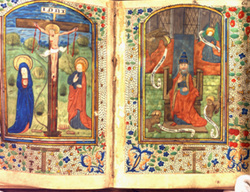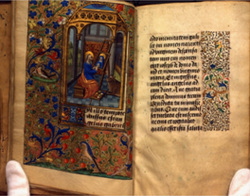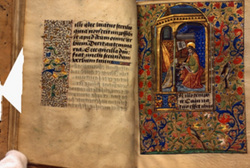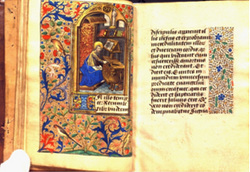Illuminating the Four Evangelists: A Comparison of Depiction in the Flemish Book of Hours and French Book of Hours by Megan Moore
Majestas Domini

Religious art found in books in the Middle Ages was full of intricacies. Each hand-painted detail was full of hundreds of years of faith and reverence crafted by the artisan for the use of the faithful. In the Flemish Book of Hours and the French Book belonging to the Loras College Rare Books collection, the artisans chose to illustrate images of the four evangelists as they are referenced in Ezekiel (1:10) and in the book of Revelations (4:6-8). The four symbols are a man, a lion, an ox, and an eagle with correlations to Matthew, Mark, Luke, and John, respectively. “From the earliest period, evangelist symbols most commonly accompany evangelist portraits, where they serve to identify the author, establish his eschatological prestige, and, sometimes, provide divine inspiration for his writings.”[1] It was St. Jerome who made the connection between the passage and the four authors of the Gospels, noting that the wings on all four symbols, most often found in artwork depicting them, is meant to be a connection to the divine.[2]
“The medieval explanation for these attributes lies in aspects of the Gospels. Matthew has the winged man or angel because he gives an account of Christ’s ancestry; the image may also relate to Christ’s incarnation. Mark has the noble lion because his Gospel emphasizes the majesty of Christ, or because of his account in the wilderness with the roar of John the Baptist’s teaching. Luke has the sacrificial bull [or ox] because he stresses Christ’s sacrifice, or because his Gospel opens with offerings in the temple. John has the soaring eagle because his Gospel is generally regarded as the most mystical; the bird may also represent the grace of the Holy Spirit.”[3]
A book of hours is “a compendium of prayers and devotions that became the most popular devotional book of the later Middle Ages. The name comes from their central and essential text, the Hours of the Virgin—more properly, the parvum officium beatae Virginis Mariae (little office of the Blessed Virgin Mary)—which consists of certain psalms, lessons, hymns, responses, prayers, and antiphons. It is called an “Hours” (Horae) because it provides texts to be recited and sung at each of the eight periods, or “hours,” of the liturgical day: matins, laud, prime, terce, sext, none, vespers, and compline…Books of hours are one of the most common of all types of surviving manuscripts of the late Middle Ages. The number, design, and quality of the illuminations in a book of hours varied greatly according to the needs, whims, wealth, and taste of the person who commissioned it…Standard sets of illustrations evolved in the fourteenth and fifteenth centuries, serving to mark the divisions of the text and to aid devotion. Scripture texts illustrated with miniatures, along with legends of the saints, served as a kind of brief sermon with accompanying visual aids.”[1]
[1] “Book of Hours,” The Dictionary of the Middle Ages.
In the Flemish Book of Hours belonging to the Loras College Rare Books collection, the reader can view the scene described in Ezekiel and Revelations, also known as “Majestas Domini,” or God in Majesty, is depicted.[1] God is enthroned and surrounded by the four creatures, symbolizing the four evangelists. However, a minority of art historians believe that it is Christ enthroned in majesty flanked by the four creatures, because it was His life and works that they documented in each of their Gospel accounts.
[1] “Evangelist Symbols,” The Dictionary of the Middle Ages, Canada: Collier MacMillan Canada, Inc., 1987.
[2] “Symbols of the Four Evangelists.” Felix Just, S.J., Ph.D. <http://catholicresources.org/Art/Evangelists_Symbols.htm> 26 Oct. 2009. Web. 27 Mar. 2011.
[3] “Evangelists,” The Dictionary of Symbols in Western Art, Sarah Carr-Gomm, Ed. New York: Facts on File, Inc., 1995.
“The medieval explanation for these attributes lies in aspects of the Gospels. Matthew has the winged man or angel because he gives an account of Christ’s ancestry; the image may also relate to Christ’s incarnation. Mark has the noble lion because his Gospel emphasizes the majesty of Christ, or because of his account in the wilderness with the roar of John the Baptist’s teaching. Luke has the sacrificial bull [or ox] because he stresses Christ’s sacrifice, or because his Gospel opens with offerings in the temple. John has the soaring eagle because his Gospel is generally regarded as the most mystical; the bird may also represent the grace of the Holy Spirit.”[3]
A book of hours is “a compendium of prayers and devotions that became the most popular devotional book of the later Middle Ages. The name comes from their central and essential text, the Hours of the Virgin—more properly, the parvum officium beatae Virginis Mariae (little office of the Blessed Virgin Mary)—which consists of certain psalms, lessons, hymns, responses, prayers, and antiphons. It is called an “Hours” (Horae) because it provides texts to be recited and sung at each of the eight periods, or “hours,” of the liturgical day: matins, laud, prime, terce, sext, none, vespers, and compline…Books of hours are one of the most common of all types of surviving manuscripts of the late Middle Ages. The number, design, and quality of the illuminations in a book of hours varied greatly according to the needs, whims, wealth, and taste of the person who commissioned it…Standard sets of illustrations evolved in the fourteenth and fifteenth centuries, serving to mark the divisions of the text and to aid devotion. Scripture texts illustrated with miniatures, along with legends of the saints, served as a kind of brief sermon with accompanying visual aids.”[1]
[1] “Book of Hours,” The Dictionary of the Middle Ages.
In the Flemish Book of Hours belonging to the Loras College Rare Books collection, the reader can view the scene described in Ezekiel and Revelations, also known as “Majestas Domini,” or God in Majesty, is depicted.[1] God is enthroned and surrounded by the four creatures, symbolizing the four evangelists. However, a minority of art historians believe that it is Christ enthroned in majesty flanked by the four creatures, because it was His life and works that they documented in each of their Gospel accounts.
[1] “Evangelist Symbols,” The Dictionary of the Middle Ages, Canada: Collier MacMillan Canada, Inc., 1987.
[2] “Symbols of the Four Evangelists.” Felix Just, S.J., Ph.D. <http://catholicresources.org/Art/Evangelists_Symbols.htm> 26 Oct. 2009. Web. 27 Mar. 2011.
[3] “Evangelists,” The Dictionary of Symbols in Western Art, Sarah Carr-Gomm, Ed. New York: Facts on File, Inc., 1995.
John

In the French Book of Hours belonging to the Loras College Rare Books collection, each symbol depicting its respective evangelist is depicted on its own page with intricate details and subtle hints as to the backgrounds of each author and their Gospel accounts.
John is seen sitting on an island that one can only assume is Patmos, a Greek island in the Aegean Sea referenced in Revelations 1:9 “I, John, your brother who share with you in Jesus the persecution and the kingdom and the patient endurance, was on the island called Patmos because the word of God and the testimony of Jesus.”[2] There is also an eagle in the illustration. John is associated with the eagle for various reasons, but most commonly for his use of high Christology in his Gospel account and the eagle being a high symbol of regality.
[1] “Book of Hours,” The Dictionary of the Middle Ages.
[2] The New Oxford Annotated Bible. Michael D. Coogan, ed. New York: Oxford University Press, 2001.
John is seen sitting on an island that one can only assume is Patmos, a Greek island in the Aegean Sea referenced in Revelations 1:9 “I, John, your brother who share with you in Jesus the persecution and the kingdom and the patient endurance, was on the island called Patmos because the word of God and the testimony of Jesus.”[2] There is also an eagle in the illustration. John is associated with the eagle for various reasons, but most commonly for his use of high Christology in his Gospel account and the eagle being a high symbol of regality.
[1] “Book of Hours,” The Dictionary of the Middle Ages.
[2] The New Oxford Annotated Bible. Michael D. Coogan, ed. New York: Oxford University Press, 2001.
Luke

Luke is depicted in a university painting a portrait of Mary with a winged ox, or sacrificial bull at his side. Luke is the patron saint of artists and students, denoted by his presence at an academic establishment. Luke’s Gospel account was also the only one containing the Magnificat, or the Canticle of Mary, which made evident her sacrifice, strength, and devotion to God, and “legend claims that he was a painter, who produced several portraits of the Virgin.”[1] The ox or bull is similar in its constant sacrifice to its master, never ceasing its efforts.
[1] “Luke, Saint,” Catholic Biblical Encyclopedia, eds. John E. Steinmueller, S.T.D., S.Scr.L. & Kathryn Sullivan, R.S.C.J., Ph.D., New York City: Joseph F. Wagner, Inc., 1956.
[1] “Luke, Saint,” Catholic Biblical Encyclopedia, eds. John E. Steinmueller, S.T.D., S.Scr.L. & Kathryn Sullivan, R.S.C.J., Ph.D., New York City: Joseph F. Wagner, Inc., 1956.
Matthew

Matthew is seen writing on a scroll in a customs house being guided by an angel or winged human. The explanation as to why Matthew is seen with a winged human is due to the genealogy found at the beginning of his Gospel account in1:1-16. It emphasizes Jesus’ human nature, that he came from a line of men, in contrast to the opening of John’s Gospel which states that the “Word became flesh,” emphasizing Jesus’ divinity.“Matthew was a tax gatherer for the Roman government. One day as he sat in the customs house, Christ called him, ‘and saith unto him, Follow me. And he arose and followed him.’”[1]
[1] “Matthew, Saint,” The Dictionary of Symbols in Western Art.
[1] “Matthew, Saint,” The Dictionary of Symbols in Western Art.
Mark

Mark is depicted in a library with a scroll and a winged lion at his side. Mark’s Gospel begins with John the Baptist “crying out in the wilderness” like a lion roaring and his narrative aggressively begins with Jesus’ mission, rather than the back story leading up to it.[1] The Gospel according to Mark was the first canonical account recorded, thus it became a source of knowledge for the other three accounts, which may be why Mark was depicted in a library in the French Book of Hours. [1] The Oxford Annotated Bible.
Conclusion
When one takes into account the individuality of each medieval manuscript commissioned, then the difference in depiction is quite simple. A book of hours was an instrument of personal devotion and reflection. As mentioned earlier, “scripture texts illustrated with miniatures, along with legends of the saints, served as a kind of brief sermon with accompanying visual aids.” Majestas Domini in the Flemish Book of Hours illuminated the text from Ezekiel 1:10 and Revelations 4:6-8, perhaps a favorite passage of the manuscript’s original owner for whom it was commissioned.The four evangelists are all saints, and more importantly, recorded the life, death, and resurrection of Jesus Christ. Their singular depictions in the French Book of Hours would allow for its reader to contemplate how one would live the life of a saint such as them. Neither depiction is better than the other, per se, but rather, serves a different purpose in its depiction of the four evangelists and allows for the reader to grow spiritually in contrasting ways when reflecting upon them.
View this essay on Issuu
Open publication - Free publishing
